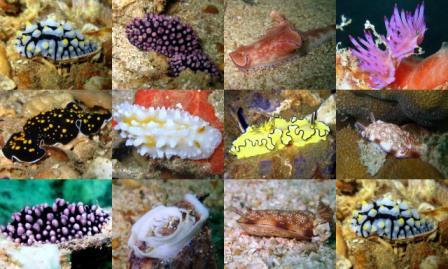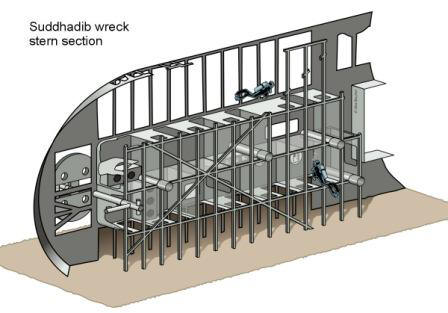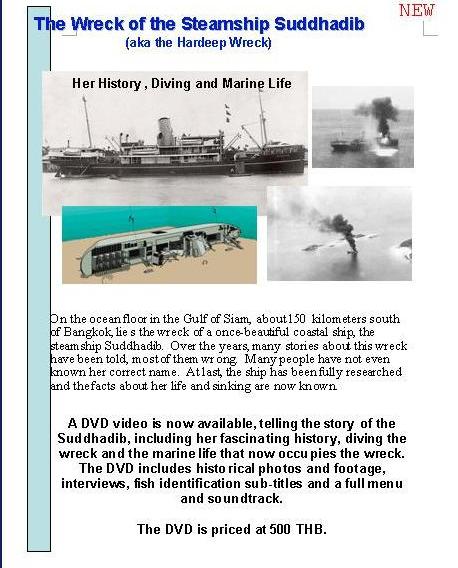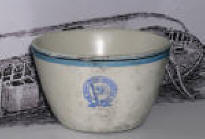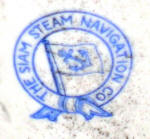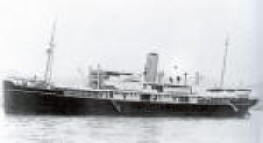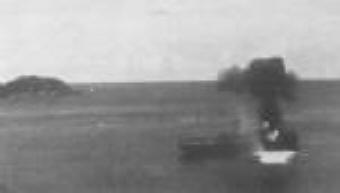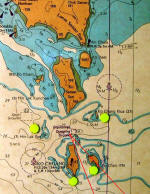The Wreck of the Steamship Suddhadib
Written by Stephen Burton
a.k.a. The ‘Hardeep’ shipwreck (An Anglicization of Suthathip, or S.S. Suddhadib)
(Pattaya, Thailand)
Wreck GPS Location:- N012’31.5, E100’57.5. Near Koh Chuang, Gulf of Siam
Vessels name:- Suthathip, Registration:-Thai, Sunk:- 1st June 1945
Depth=26meters ; Suitable for Air, Nitrox, technical diving
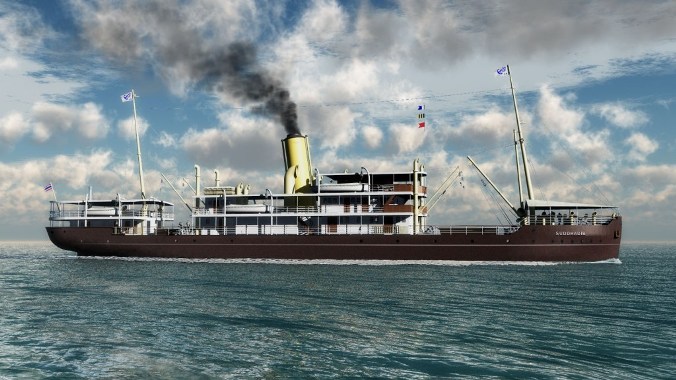
click any image above for HIRES 1MB .jpg image
All Computer generated images courtesy of Mr Alex Beuchel, [email protected] Used with permission.
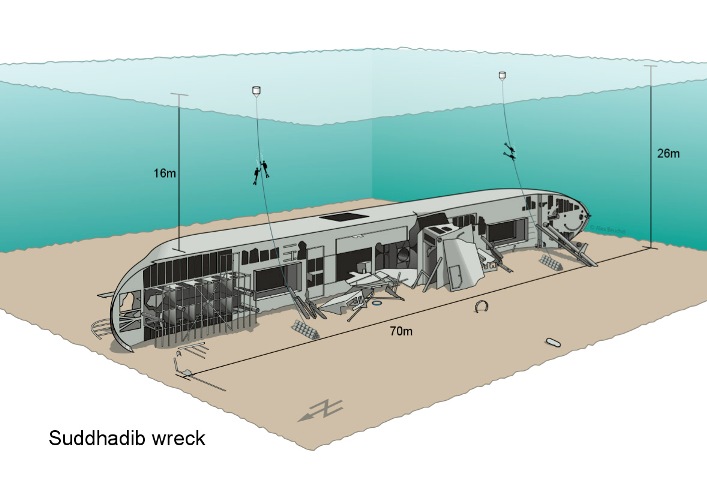
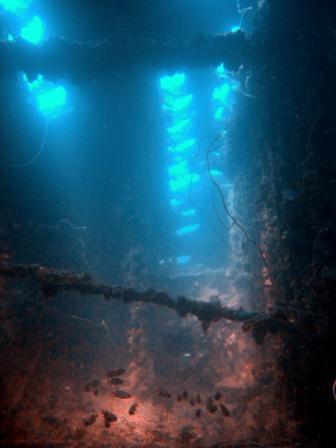
click image for 200K image. Click HERE for HD 4Mb image
Nudibranchs on the Hardeep Ship wreck, hardeep Cathedral Photo – by diver Charlie Frost – Used with permission
Latest Images – The Suddhadib Re-created: by Alex Beuchel May 2010
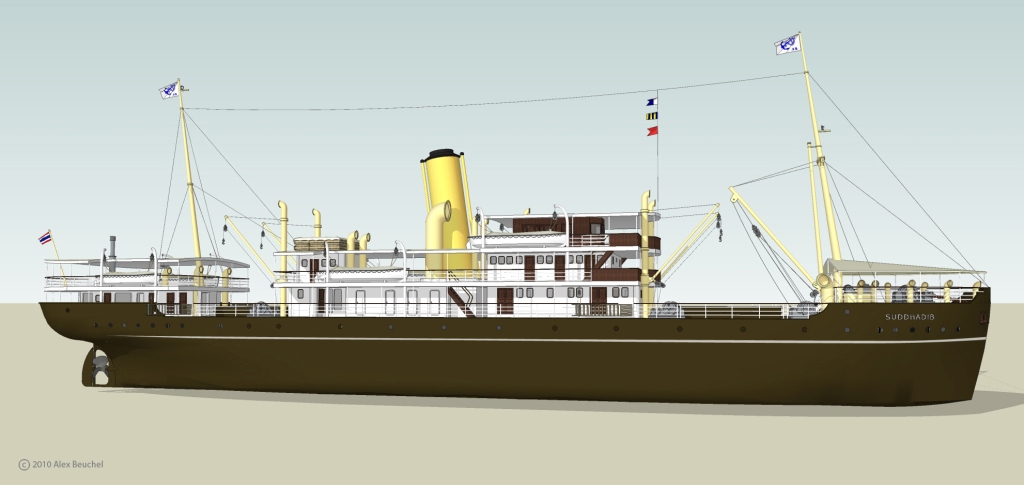
Click any image below for Hi-Res 250K JPG Image
click any image above for HIRES 1MB .jpg image
New images from Alex Beuchel Survey Jan 2008
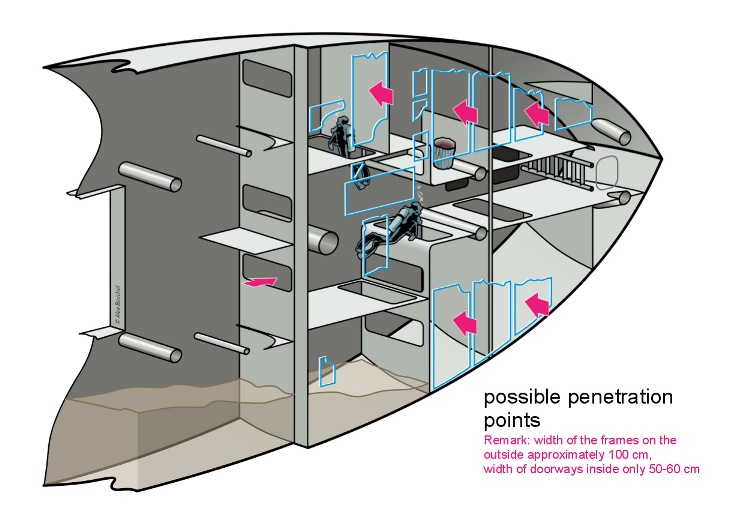

(click image for hi-res pictures (200Kb each picture)

“I recently started working with a 3D software called SketchUp which can be downloaded free through Google. They distribute it as public domain software for people around the world to model their cities and homes in 3D to be used in Google Earth
“It is quite simple to learn and they have great online tutorials. Next to it they published a program called SketchUp Viewer for people who only want to view a model in 3D, rotate it and walk around in it without modifying the model.
“I took all my existing data that we had collected to draft up the 2D maps that I had done and now applied it to a 3D model. Took some time, but was a lot of fun to see the Suddhadib grow in 3D on my screen. But as you know me, no little detail went unnoticed. If a hole in a bulkhead had a certain shape it now has that shape in my model – nothing random” – Alex Beuchel
All Computer generated images courtesy of Mr Alex Beuchel, [email protected] Used with permission.
Suddhadib- Hardeep shipwreck DVD
A truly outstanding example of shipwreck research and wreck diving documentary.
Diver & shipwreck researcher Peter Walker assisted by a team of keen professional divers unravel the history of one of Thailand’s most popular shipwrecks.
From a standing start Peter has succeeded in completely researching the history of what was, a mystery shipwreck. Never before seen footage and actual aerial photography of the bombing raid that sunk the Suddhadib, establish for the first time what really happened in 1945 when the Royal Thai Navy at anchor was attacked by a squadron of B24 liberator bombers.
Peter’s clear ‘BBC style’ presentation and multi-lingual detective skills comb through Thai naval history and cross the world to trace the actual bomber crews involved in this raid 65 years after the sinking, for a first hand ‘on camera’ interview of what it was like to be there during a low level bombing run against enemy shipping.
Underwater video footage clearly documents all aspects of diving this wreck including penetration diving into the more challenging areas that are out of reach to recreational divers. The video survey also documents the many unexploded bombs that still litter the seabed around her, and the dozens of species of marine life that have made this shipwreck there home.
This comprehensive DVD with a fully featured bonus section, makes this a ‘must have’ item for all wreck divers visiting Thailand.
Contact the DVD’s publisher Mr Peter Walker Directly for a copy of this DVD [email protected]
Specifications and Historical Records

Nice cup found by James Curtis, 24 May 2007
Pictures below are of a sword and scabbard
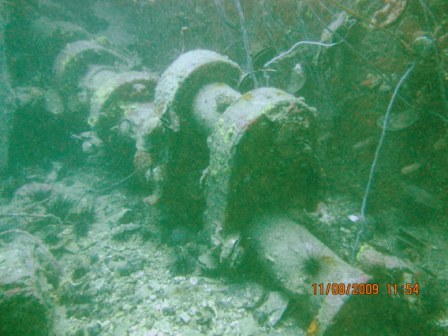
HardDeep Engine Room at depth=25m, August 2009 – Photo courtesy Charlie Frost
Vessel type:- Cargo ship Length
3 cylinder steam engine (105.5 horse power). The length of the ship is 68.11 meter, beam 10.84 meter, height 5.43 meter. The size is 802.97 ton net. Registration date 12 July 1940 , registration number 447 port Bangkok .
Siam Steam Navigation Company
HP 900, BRT 1.311, TDW 955
Thai History of the sinking
Courtesy of Mr Peter Walker & Royal Thai Navy sources. updated August 2005
I thought you might be interested in seeing the attached photo of the “Suddhadib”. This is certainly an early photo of the ship that you dived on all those times
click for hi-res image 485Kb
Within hours of a Thai friend telling me that there are two ways to spell Suthathip, and that Suddhadib was the more traditional way, it opened up a whole new avenue of research.
Here is what I now know (almost all information confirmed from two separate sources):
- Built 1918 in Hong Kong by the Hong Kong & Whampoa Dock Company (still seeking their records)
- Built for the Siam Steamship Co (part of the East Asiatic Company (EAC) – Bangkok-based, Danish owner)
- Named after the favorite (and most beautiful) daughter of King Rama V, Correct name: Suddhadib
- Princess Suddhadib attended the blessing when it arrived in Bangkok in 1919 and was presented with a silver model of the ship (it would be nice to find that model in a museum)
- Carried passengers and cargo around Thailand and SEA
- Appropriated by the Thai government in 1940 and shifted registration to Thai Navigation Company (Govt owned)
- Carried cargo and fuel during WW2
- Suddhadib sent to Singapore in 1945 to collect fuel supplies, partly for Thai Fuel Company (predecessor of PTT), partly for Japanese army.
- Could not return to Bangkok due to mines in mouth of the Chaopraya River
- Instead anchored in Sattahip naval base in late May 1945
- Some fuel offloaded
- RAF Bombing raid around 6pm on 30th May 1945 – medium altitude, bombers missed all targets
- Moved to present location near Samaesan on 31st May 1945
- RAF Bombing raid around noon on June 1st 1945
- RAF B24 liberator squadrons 99 and 159, 23 planes, 5x1000lb bombs each
- Crews were a mixture of British, Australian and Canadians (3 pilots still alive today)
- B24s flew 6 hours from near Calcutta in India, 20 minutes over targets and then 6 hours back to India – through monsoon weather at 10000 feet – very bumpy.
- Very little defenses around ships (I don’t understand why Thai admiral moved his ships away from the strong defenses around the Sattahip naval base)
- Low and medium altitude bombing runs
- Five bombs dropped on Suddhadib, one hit near bow, ship on fire (previous photo).
- Suddhadib quickly sunk, no loss of life, crew swam to Koh Chuang
- In the same raid the HTMS Angthong sunk and 6 other ships badly damaged
- The Suddhadib had a sister ship the Valaya (sunk by mines in the mouth of Chaopraya River 1944)
The latter part comes from Thai naval records which I translated yesterday and confirms exactly the RAF operation logs that I sent you earlier.
Regards
Peter Walker
+++++
More details courtesy of the Royal Thai Navy archives and Khun Pichit Muangnapoe.
Suthathip Wreck is a steam ship build by Dearn Rua Thai company (Thai Shipping Co.), it was built to be use as a cargo ship for Hong Kong and Vambua company. The name of the engineer who built the ship is Mr. K. Farsdao. Suthathip is a one propeller with 3 cylinder steam engine (105.5 horse power). The length of the ship is 68.11 meter, beam 10.84 meter, height 5.43 meter. The size is 802.97 ton net. Registration date 12 July 1940 , registration number 447 port Bangkok .
Dearn Rua Thai company use Suthathip as cargo ship approximately 3 years before was called by the Royal Thai Navy to assist in the WWII. On the 30th of May 1945 , Satahip bay was heavily hit by the allies bombing airplanes. Navy admiral Kanok, commander of the second Navy unit ordered Suthathip and other 8 warship to find a better place to anchor. Suthathip and 3 others ship were anchored in front of Koa Chuang.
On the 1st of June, 12.36 pm, 10-15 bombing squadron attack the place where Suthathip and other ship were anchor. H.T.M.S. U Thong, H.T.M.S Angthong and H.T.M.S. Tha Chin were hit bit still afloat while Suthathip which did not have any cannon to protect herself was severely hit, caught on fire and sank at 12.55 pm .
Some say that the original name of the ship is “Hardeep”, but was called “Suthathip” after she sank as the resting place is right in front to Suthathip bay, Koa Chuang.
Details of Sinking
There have been numerous rumors surrounding the Hardeep s sinking. They are included here for historical record. The most correct version from Thai Naval Archives is included above.
Sinking theory #1:- The Harddeep was sank by French aircraft while re-supplying the Thai armed forces during the Thai-Franco hostilities during 1941.
Sinking theory #2:- The Harddeep was sunk by Australian/New Zealand aircraft while carrying a cargo of construction equipment for the Japanese ‘Death Valley’ railway project while on a voyage from Indonesia to Satahip Naval base.
Evidence of sinking method
Aerial Bombing Picture Courtesy of Peter Walker. RAF Sources. [[email protected]]
Evidence that the Harddeep was sunk by an aerial attack is furnished by the two large unexploded 1000 pound bombs lying on the sea bed near the wreck. Both bombs lie approx 100-150 meters aft of the vessel at a depth of 27-33 meters. The bombs have brass nose and tail fuses, and were probably dropped from insufficient height to arm themselves before striking the water. That a bomb exploded nearby to the ship and caused it’s sinking is evidenced by a large tear in the plates on the port side of the aft cargo hold. This large fracture would have sunk the vessel in minutes. Fuses often have serial numbers on them, when I’m bored with life one day, I’ll knock the barnacle encrustation off them with a lump hammer and chisel to read the numbers. Volunteers for this exciting piece of research may contact me at my usual address…
Wreck details
The Harddeep lies on its starboard side at a max depth 26 meters, with two unexploded 1000 pound bombs nearby. The entire structure is encrusted in heavy coral growth and makes a lovely ‘cavern’ dive. It is possible to swim from one end of the wreck to the other without leaving the wreck. Both large forward and aft holds offer safe, well lit penetration dives for all but the chicken scared. The large steam engine has been removed through a purpose cut hole in the side making access to the engine room easy. Remains of the funnel and chain winch capstans lie on the seabed nearby. In all likelihood the large brass prop would have been removed by local Thai salvagers before it stopped spinning, and what remains of the cargo is nowhere to be seen. Large lumps of coal rest in the engine room next to the 3 enormous boilers. Once having battled down the line against the fierce currents that often flow over this wreck, the Harddeep makes for a lovely dive. There is a lot of sea life on the wreck including a resident turtle, a few rays, the usual giant grouper, and a giant starry puffer fish often lurking just above the boilers. When diving the wreck aim to be first down the rope before other cretins scare them away. B2
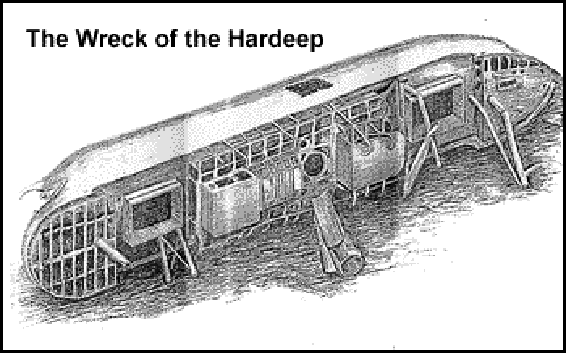
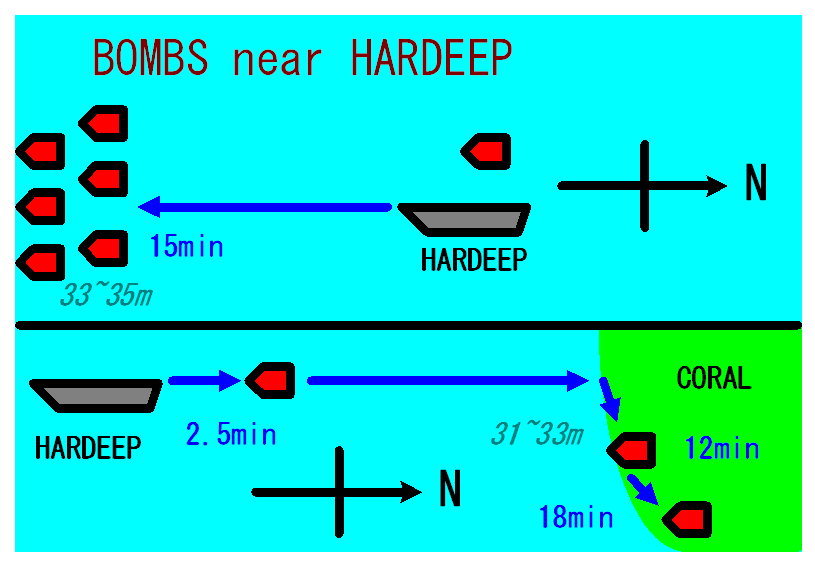
New Research August 2005
Phone: +66-1-374-7034
Email: [email protected]
URL: http://www.peterwalker.com
[Peter Walker]–> My investigations with the RAF have returned some information and an operations log that appear to confirm the Thai navy record of the sinking of the Suthathip (Hardeep):
On the next day, 1 June 1945, fourteen aircraft of No. 159 Squadron were ordered to return to Satahib Bay. Four aircraft, were detailed to lay mines – “F” captained by P/O J.A. Atkins, “H” by P/O R.R. Temple-Smith, “Q” by W/ O Newman, W., and “V” by F/O E j. Foot, R.C.A.F. Ten aircraft were detailed to attack enemy shipping in the Bay – “T” captained by the C.O., W/C L.B. Ercolani, “R” by F/L C.F. Williams, R.C.A.F, “B” by F/O E.B. Robinson, R.C.A.F, “Z” by F/O S. Kinnear, R.C.A.F, “J” by F/L R.W. Williams, “A” by F/ L R.M. Borthwick, R. C.A.F., “K” by P/O T. L. De Nett, “C” by S/L TW. Watson, R.C.A.F, who had been recently promoted to senior rank, “U” by P/O M.C. Mazengarb, and “D” by P/O R. Lee. The aircraft took off at Digri before six in the morning and returned around eight at night. Over the target area there was good light and visibility with scattered high cirrus cloud. The primary target was the Anthong Depot Ship.
The previous medium level attack had been carried out against this Thai naval anchorage without achieving spectacular success. Chiefly this was due to the difficulty of obtaining hits on moving surface craft from medium level bombing. This time the plan was first for some aircraft again to bomb from medium level. Then, when all attention was directed to this attack some aircraft would skip in at low level and do their work. At the same time four aircraft would mine the entrance to the harbour to discourage escape. The C.O. served as master bomber to direct the attack.
The attack went well and according to plan. The Anthong class submarine depot ship was hit and left burning fiercely from end to end. Eventually it heeled over and sank. The crew of aircraft “R” (F/L. C.F. Williams) attacked a small tanker which exploded from a direct hit, followed immediately by fire and black smoke. The ship sank in 3-4 minutes leaving debris and oil on the sea. A 250 foot sloop was bombed amidships and seriously damaged. There was meagre and inaccurate light A/A from known positions. Other shipping was strafed and on the way home aircraft “H” (P/O. Temple-Smith) strafed trains at Bhejburi with great success. Box cars exploded violently producing brilliant red flashes and heavy black smoke. Altogether it was a successful operation and all aircraft returned safely to Digri. Aircraft “K” (P/O. De Nett) landed at Ramree on the way home with a failing engine. Aircraft “Q” (W/O. Newman) returned early after encountering adverse weather conditions. Aircraft “Z” (F/O. Kinnear) developed engine trouble and could not take off.
Now take a look at the operation log book (attached). In particular, note the comments about the bomb passing through the ship and exploding underneath. This might explain why the ship is not damaged the way you would expect it to be if a 1000 lb bomb had exploded onboard.
And compare it with what the Thai Navy said:
On the 1st of June, 12.36 pm, 10-15 bombing squadron attack the place where Suthathip and other ship were anchor. H.T.M.S. U Thong, H.T.M.S Angthong and H.T.M.S. Tha Chin were hit bit still afloat while Suthathip which did not have any cannon to protect herself was severely hit, caught on fire and sank at 12.55 pm.
Here is why I believe that this information from the RAF corroborates the Thai navy record:
- Date (1st of June) and time of day (around noon) is the same
- Low level bombing using 1000 lb bombs (low level explains why some did not explode)
- Both accounts mention the H.T.M.S. Angthong, a submarine depot vessel (although the RAF thinks they sunk it)
- 250 foot sloop (250 feet = 76 meters) almost exactly same length as our ship. This meaning of sloop could be a “small antisubmarine warship used to defend convoys.” Remember, the RAF’s mission was to bomb the Angthong, so they probably associated all nearby vessels with its submarine role)
- Number of planes – Thai Navy: 10 to 15 compared with RAF 14 B24 Liberators
Fishermen using explosives damage HTMS Chuthatip and coral reefs
Jan 2007

A special patrol was sent out to investigate after receiving reports that fishermen in the area are using explosives to fish.
Patcharapol Panrak
Fishermen using explosives in the ocean off Sattahip have caused damage to underwater sites, leading to a drop in the number of tourists diving in the area.
The sunken World War Two warship HTMS Chuthatip in Saem San Bay is amongst the sites damaged, and dive tour operators are complaining that the bay’s exotic fish are being frightened away.
Captain Chamnong Kittipiraphol, commander of Fleet 1 at Sattahip, says that many complaints have been received from Thai and foreign tourists that explosives have been used by fishermen around various islands in Saem San Bay and also around the area where HTMS Chuthatip has been laid to rest, between Koh Juang and Koh Rong Khone.
Tourists are saying there are no scenic diving spots left and that all the large fish have deserted the area. Captain Chamnong reported the matter to Admiral Nopporn Achavakhom, commander of the Strategic Fleet, before sending his deputy Captain Pachon Ramkomot and a team to investigate.
They found that explosions have occurred around HTMS Chuthatip, which lies 26 meters under the surface. The patrol investigated the various islands in the area and found that a lot of damage had been done to the coral reefs. Tourists and dive tour operators are now being asked if they have any information on who is carrying out the illicit bombings. Call the Strategic Fleet Command on 038-438008.










